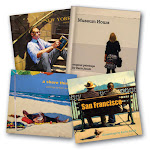6 x 8"
oil on panel
sold
sold
I saw this exquisite painting at the Delaware Art Museum a few years back. I felt .... lucky. There haven't been many chances in my life to see those Pre-Raphaelite portraits of women in their luxurious clothes and settings. They're so yummy.
The painting in my painting is 'Veronica Veronese' by Dante Gabriel Rosetti, done in 1872 - first sold to a frequent collector, a rich shipping magnate Frederick Leyland, changed hands a few times then it was donated to the Delaware Art Museum in 1935.
Rossetti's painting is filled with symbolism - the uncaged bird, the daffodils, the camomile in the cage. Rossetti was English, a co-founder of the Pre-Raphaelite Brotherhood of artists and poets, which evolved through the years.












